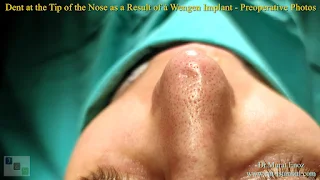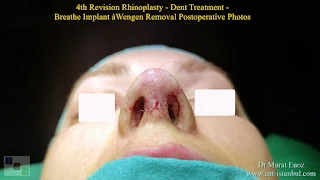Dent at the Tip of the Nose as a Result of à Wengen Implant and Permanent Stitch Reaction
Attention: The content in this video and the photographs in this link may be disturbing!
The patient, who had previously undergone nasal surgery 3 times in different clinics, applied to our clinic due to a dent in the tip of the nose. In the patient's anamnesis, it was learned that in his last surgery, the Breathe Implant àWengen, made of titanium, was placed in the nose due to the collapse of the nasal wings. During the examination, a dent area with a diameter of approximately 6-7 mm was detected on the nose skin. An open technique revision rhinoplasty operation was planned for the patient.
The tip of the nose is the area of the nose that attracts the most attention and is very important in facial expression. Even minor asymmetries here can sometimes be disturbing for patients. The patient I shared here stated that he did not want to take photographs and that this indentation on nose after rhinoplasty was visible from every angle. Unfortunately, due to the change in the subcutaneous tissue and the formation of scar tissue, it is not possible to fill this dent area with a simple filler injection. As I shared with you here, it is ideal to remove the underlying suture materials and foreign body that caused this area to form, and to place a cartilage graft or soft tissue for filling purposes in this area. Sometimes, when dissecting areas with dents in the skin, perforation and skin injury may occur in this area. Therefore, the surgeon must be very careful when elevating the skin.
Revision rhinoplasty surgeries are always, as I always say, a process akin to "unboxing a surprise box." In cases like this patient, addressing both the elevation of the depressed area in the skin is challenging, and understanding the underlying issue is not easy. The persistent, non-absorbable suture reaction and recurrent inflammatory processes have led to this alteration. In cases like these, treatment with the closed technique is quite challenging. Open rhinoplasty, controlled tissue dissection, understanding and addressing the cause, and supporting the depressed area under the skin with an adequate amount of graft are fundamental treatment principles.
Understanding and Managing Dents After Rhinoplasty
Rhinoplasty, commonly known as a nose job, is a surgical procedure performed to reshape or reconstruct the nose. While the primary goal is to enhance facial harmony and improve aesthetic appearance, patients may occasionally experience complications or side effects. One such complication is the development of dents or irregularities in the nasal contour post-rhinoplasty.
Causes of Dents After Rhinoplasty
Inadequate Cartilage Support
Dents may occur if the cartilage framework supporting the nose is insufficient or weakened. This can happen when the surgeon removes too much cartilage during the procedure, leading to a lack of structural support.
Permanent stitch reaction (foreign body reaction)
As I shared with you in this case, the recurrent foreign body reaction and tissue changes caused by the prolene suture material seen in blue color caused a dent in the skin. Breathe Implant à Wengen is made of titanium and is placed to open the nasal valve and support the lateral nasal cartilages. When fixing these implants, they should be covered with a thick layer of skin as much as possible, in other words, permanent suture materials should not be close to the skin. When the foreign body reaction to prolene sutures begins, the suture materials move towards the surface. This dent occurred due to the inability of the suture material fixed with the titanium implant to move towards the surface and permanent changes in the skin.
Scar Tissue Formation
The formation of excessive scar tissue during the healing process can contribute to irregularities or dents. Scar tissue may contract or distort the nasal structure, resulting in an uneven surface.
Over-resection of Bone or Cartilage
Aggressive removal of bone or cartilage can lead to an unnatural appearance and the formation of dents. Striking the right balance between achieving the desired aesthetic outcome and maintaining structural integrity is crucial.
Poor Healing or Tissue Necrosis
Complications such as poor healing or tissue necrosis can compromise the overall outcome of rhinoplasty. Inadequate blood supply to certain areas of the nose may contribute to the development of dents.
Managing and Preventing Dents
Choose an Experienced Surgeon
Selecting a board-certified and experienced plastic surgeon is paramount to minimizing the risk of complications. An experienced surgeon will carefully evaluate your facial anatomy, discuss realistic expectations, and employ techniques that prioritize both aesthetics and functionality.
Open Communication with Your Surgeon
Clear communication with your surgeon is essential. Discuss your concerns, expectations, and any apprehensions you may have before the procedure. This ensures that your surgeon understands your goals and can tailor the approach accordingly.
Follow Post-Operative Care Instructions
Adhering to post-operative care instructions is crucial for a successful recovery. This includes avoiding activities that could put stress on the nose, following medication schedules, and attending follow-up appointments as advised.
Consider Revision Rhinoplasty
In cases where dents have already developed, revision rhinoplasty may be considered. This involves correcting the existing issues and improving the overall aesthetic outcome. It is essential to wait until the initial healing is complete before considering revision surgery.
Dent Treatment After Rhinoplasty
It is important to understand the underlying cause and to make the skin surface smooth again by filling the dent area with grafts such as soft tissue, temporalis fascia and cartilage during the surgery. An open technique 4th revision rhinoplasty operation was planned for the patient whose photos are presented above, and during the surgery, the underlying permanent suture materials (prolene thread) and Breathe Implant àWengen were removed from the dent area. Camouflage grafts consisting of soft tissue and cartilage were placed in the collapsed skin area and all permanent threads were removed. Different cartilage grafts (obtained from rib cartilage) were placed at the tip of the nose and nose wings to support them.
While dents after rhinoplasty can be a source of concern, understanding the potential causes and taking preventive measures can contribute to a more successful outcome. Choosing a skilled and experienced surgeon, maintaining open communication, and following post-operative care instructions are key steps in minimizing the risk of complications and achieving the desired aesthetic results. If dents do occur, timely consultation with your surgeon can help explore appropriate solutions, including revision rhinoplasty, to address the issues and restore a natural and pleasing nasal contour.
Below are the preoperative, intraoperative, postoperative and postoperative 1st week photographs.
4th Revision Rhinoplasty - Dent Treatment - Breathe Implant àWengen Removal Before and Immediately After Surgery Photos
Preoperative Photos
Photos During Surgery
 |
| Breathe Implant à Wengen |
 |
| Breathe Implant à Wengen |
 |
| Breathe Implant à Wengen |
4th Revision Rhinoplasty - Dent Treatment - Breathe Implant àWengen Removal Before and Immediately After Surgery Photos
Post-Surgery 1st Week Photos
 |
| As seen in the photo above, after 1 week, it can be seen that the skin at the tip of the nose is quite healthy and tidy, and no dents appear. |
The Risk of Skin Dentition Increases After Repeated Rhinoplasty Operations!
When rhinoplasty operations are performed repeatedly, unfortunately, the risk of irregularities on the skin increasing when subcutaneous dissection is performed repeatedly. Subcutaneous dissection is performed during rhinoplasty operations. Although different techniques are used, when the distance between the cartilage and the skin is continuously tightened repeatedly, the tissue under the skin may become irregular. The risk of fibrotic healing tissues due to recurring sacs, suture reactions, irregular skin after cartilage grease placement and the emergence of small dents on the skin when healing is completed increases. Apart from the patient I shared with you here who had a suture reaction and a dent on the skin outside the area where the suture reaction occurred, there are patients who have dents on different areas of the nose after a very successful nose tip aesthetic or nose tip aesthetic. Edema that occurs in the early period after surgery may prevent the dents on the nose from becoming apparent. After healing is complete, irregular pits on the nose skin become more apparent. Avoiding permanent stitches as much as possible, avoiding rhinoplasty operations that involve repeated large dissections as much as possible, and applying minimally traumatic procedures can prevent irregularities that may occur on the skin of patients. Skin dents that occur after the recovery from rhinoplasty surgery is complete usually cannot be treated with simple filling applications. The scar and fibrotic tissue that appear under the skin prevent the filling from expanding this area. The most beneficial procedures are to place tissues such as cartilage, soft tissue or temporal fascia that will add volume to this area. When patients who have had repeated rhinoplasty surgeries before consider having another rhinoplasty surgery, they should be informed that these dent areas may be damaged during dissection or that the dents cannot be completely treated. When one or two dents occur on the skin of the nose, it may be appropriate to perform minor procedures only on these areas. No surgical procedure is without risks, and there is a possibility of dents and similar skin problems occurring after repeated rhinoplasty operations.
Similar link >> Titanium Implant Permanently Placed In The Nose For Those Who Cannot Sleep Without Nose Band: "Breathe Implant àWengen" (ent-istanbul.com)
Murat Enoz, MD, Otorhinolaryngology, Head and Neck Surgeon
Private Office:
Address: İncirli Cad. No:41, Kat:4 (Dilek Patisserie Building), Postal code: 34147, Bakırköy - İstanbul
Appointment Phone: +90 212 561 00 52
Appointment Phone: +90 212 561 00 52
Fax: +90 212 542 74 47








































































Comments
Post a Comment